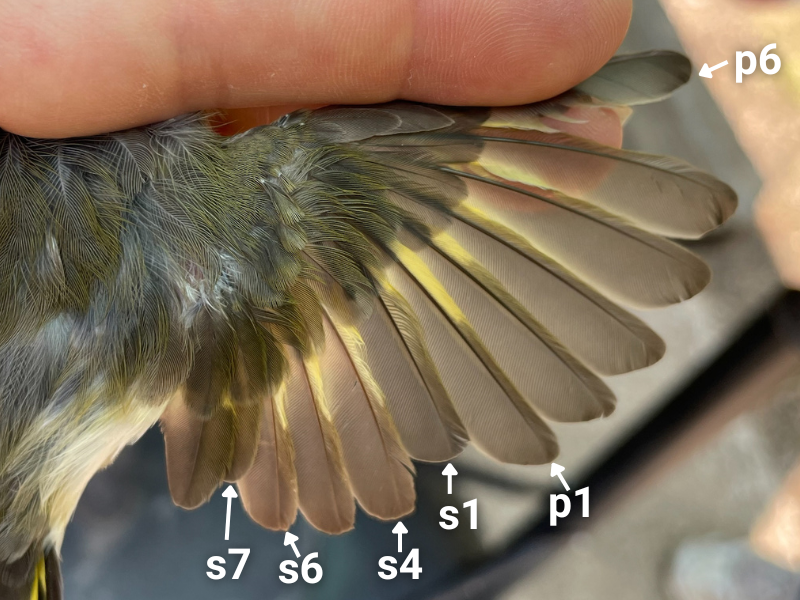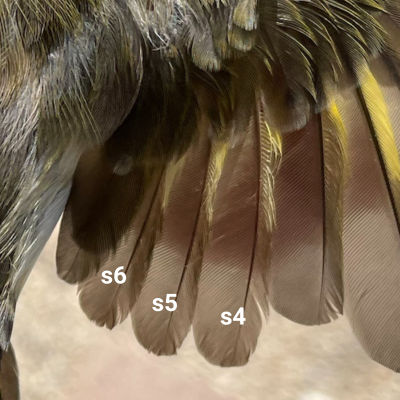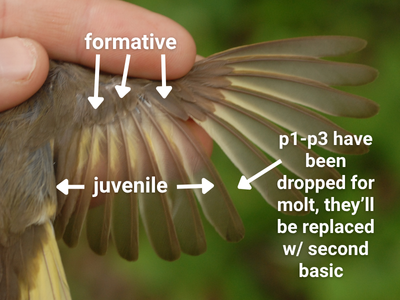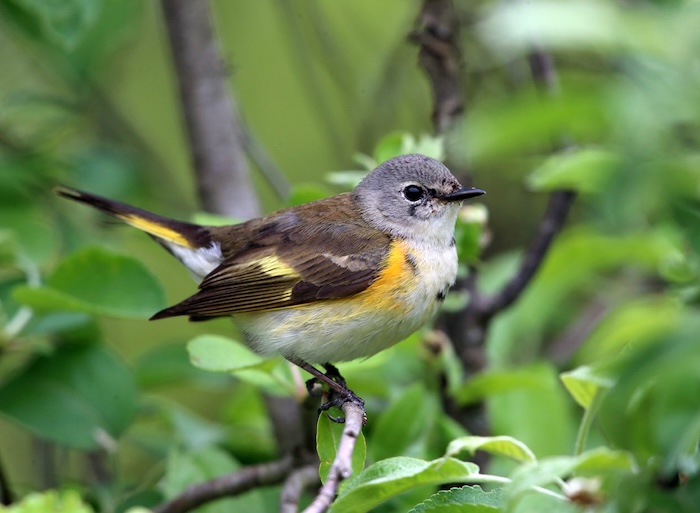It has been a while since our last “Ask Peter” post. Moving and rehabilitating a distressed ranch along the Mendocino coast has kept Peter Pyle busier than usual. Now that he's settled in, Peter is catching up on a few questions from the past couple of years and looking forward to more tricky molt and ageing questions, so keep them coming!
On 23 July 2023 (two years to the day that Peter is writing this!) Austin Broadwater and Eve Cusack captured this American Redstart at their Kent Farm MAPS Banding Station in Indiana, and asked:
We sexed this bird as a female, but for age, we are not sure. Currently, this is going as an SY (second year) bird or M-SPB (minimum-second prebasic molt). It seemed to have juvenile alulas and primary coverts, the rest of the coverts being basic (with ongoing molt in median coverts), and ongoing molt to basic secondaries and primaries, as well as ongoing prebasic molt in the rectrices. Does this seem correct? And how would we best rule out if it was just a really messy ASY (after-second-year) bird undergoing DPB (definitive prebasic) molt?

Wing of American Redstart banded in July 2023 by Austin Broadwater and Eve Cusack.
Peter responds: Great analysis and questions! First of all, it is indeed a female. Had it been a male, the new primaries would be black and orange, so we can dispense with worrying about sex. Second, the molt of flight feathers means this is not a HY (hatch year). Male AMREs are one of the easiest of our passerines to micro-age (ie., age to SY and ASY) while, ironically, females are one of the most difficult, even before the prebasic molt begins. And when it is almost complete, as here, well, AHY (after hatch year) is often the best course. But can we micro-age this bird?

A close-up on the secondaries on the American Redstart that Austin and Eve asked about.
It is molting in a sequence perfectly typical of the great majority of passerines and birds: primaries are replaced outward (p1 to, in this case, p9); at about the time p2-p3 are molting the tertials begin to be replaced in order s8-s9-s7; when primaries have reached p4-p6 the rectrices start molting, in general outwardly from the central (r1) to the outer r6 but often with some variation; and at about the time p6-p7 are dropped outer secondaries begin replacement from the outermost s1 inward. All of this means that the last feathers typically replaced are among p8-p9 and s4-s6. We can't see these primaries in the images, but the s4-s6 are clearly older and unmolted (s7 is growing, s1 is new, and s2-s3 are dropped). So the question is, are these juvenile secondaries on an SY (undergoing second prebasic molt) or are these basic secondaries on an ASY (undergoing definitive prebasic molt)?
Looking at the first photo, I'm not sure of the feather generation, and would likely go with AHY based on this uncertainty. The flight feathers of breeding female passerines typically get very worn due to nesting responsibilities, and these do not look so bad, so I'd probably lean ASY. As alula, outer primary coverts, and outer primaries get the most exposure, these can often be very worn in ASYs, as noted by the banders. In the second photo, I see a subtle freshening from s4 to s6. I call this a "molt cline" whereby you can see slight freshening from p1 to p9 and from s1 to s6, reflecting the molt sequence noted above and indicating at least one previous complete molt on an ASY. Note also that the shafts of these three feathers are blackish (they are usually much browner in retained juvenile feathers). So, I feel confident enough about this that we can call this an ASY female.
I'm pleased, by the way, to see Austin and Eve considering WRP codes for this. The most current revised codes are gradually gaining wider usage (see our recent paper on this here). M-SPB would be the right code if we ended up with AHY for this bird. If we were confident it was a SY we'd call it an SPB, and if we were sure it was an ASY, we'd call it a DPB. So per the above, I'd be fine age-coding this female AMRE with DPB (ASY).

An American Redstart banded in Alberta Canada in July 2015. Note that most of the greater coverts have been dropped in molt.
For comparison, here is an SPB (SY) female AMRE captured for banding during our Boreal MAPS Project in Alberta on 14 July 2015. In this case, molt is not as far along, with p1-p3 and most greater coverts dropped, but there is a single unmolted formative greater covert that still contrasts in freshness with the brown juvenile primary coverts. Going back to the Indiana bird above, note especially that the secondaries are uniform in wear, without a molt cline, and that the shafts (along with the rest of the feathers) are much browner. For more on our Boreal MAPS program along with taking images like this for digital catalogues, see pp. 18-22 in the 2025 issue of MAPS Chat.






